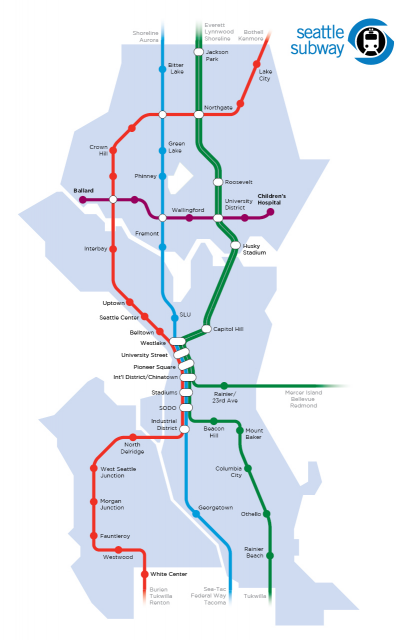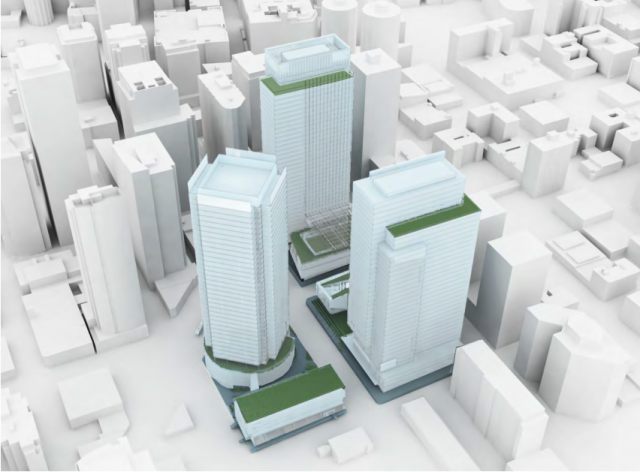Seattle Subway: “We want it all, and we want it now”
Saturday afternoon I sat Seattle Subway‘s Ben Schiendelman down at the Hopvine and asked just what the heck was going on.
Schiendelman is an interesting character: a software engineer and transit enthusiast (he’s one of the gang at Seattle Transit Blog) who’s evolved into a transit advocate, willing to plunge into the messy and often-arcane realm of political action to get things done.
That impulse, simply to speed things along, is largely what the new non-profit Seattle Subway (over 1,600 fans on Facebook) is about, the catchy, “envisionary” full-system graphic aside. (Ballard! West Seattle! It’s like someone’s planning to reattach Seattle’s arms.) Underground, aboveground, they don’t really care, so long as the net result is speed.
Sound Transit already has big plans for light rail in the region, it’s just that because it is a regional entity, it often has to move at a slower pace, as intransigent anti-transit forces are won over and voters in less-wealthy areas agree to allocate the revenue to pay for infrastructure. As a compromise Sound Transit has been breaking out its big transit projects into “phases,” all of which require ballots marked “Yes.”
Seattle Subway wants to leverage Seattle’s bias to vote pro-anything-transit, even a Monorail. In fact, that failed Monorail project has given them an idea. I’ll let The Stranger‘s Dominic Holden summarize:
Here’s how it would work: Seattle voters would take advantage of the City Transportation Authority, created by the state legislature in 2002, which was intended to fund the monorail. That authority still allows voters to establish a motor vehicle excise tax of up to 2.5 percent for “a transportation system that utilizes train cars running on a guideway.” An initial vote as soon as this November or next year could pay for relatively inexpensive analysis and design work for the first line—probably to Ballard and West Seattle.
As Schiendelman is careful to emphasize, the idea is not to compete with Sound Transit, but to help turn a tortoise into a hare. If you map out all that Sound Transit means to accomplish, at its current rate of returning to voters for piecemeal approval, it might take a century. With Seattle giving a push, Schiendelman asks, could we bring that down to 30 years?
For a start, if the City Transportation Authority can front-load the money for studies and planning Sound Transit still needs to do, progress there could be made in 2013, instead of 2016. Slice three years off here and there, it starts to add up. So Seattle Subway’s first goal is to figure out if they can, using the CTA, get on the 2013 August primary ballot with a proposal to raise planning moneys for Sound Transit.
If you are a transit wonk, this all makes perfect sense. But if you’re looking at paying the motor vehicle excise tax, you might need a little more reason to take transit on your shoulders. As it happens, by coincidence, Amazon wants to build a very good reason to invest heavily in Seattle transit right now. Let’s take a look at Amazon’s timeline: Back in February, it was still a rumor that the internet retailer was interested in buying twelve acres of land, near Whole Foods on Denny, for a corporate headquarters.
At this precise moment, land purchased, they are seeking to fast-track permitting for Rufus 2.0, a new campus of three towers, adding up to three million square feet of office space. For New York-style contrast, that’s a little more than the amount of floorspace in the 102-story Empire State Building (2.7 million sq. ft.) and, for ironic contrast, about the same size of an old Chrysler plant. Each of Amazon’s towers would be up to 40 stories tall, with a “series of 5-6 story structures at their base.” They would like to get the Master Use Permit squared away by December 20, 2012, thanks.
“The company reported recently that it ended 2011 with 56,200 employees, a 67% increase from the prior year,” noted the Wall Street Journal recently, but that was soon out of date. Geekwire provides the new total: 65,000. Amazon won’t tell you how many of those employees work in Seattle, but however you slice it, you can’t get that many more people on Denny. Let me quote The SunBreak (full disclosure: me) on this:
Again, there is no solution envisioned, even as South Lake Union bulks up with Amazon, PATH, and Gates Foundation employees. We are simply supposed to accept as the natural way of things that public transit means taking 45 minutes to travel what could take seven minutes. Maybe it’s time to elect an engineer of some kind to the City Council?
(Sidebar to City Council: You know what makes a great public benefit package? GONDOLAS!)
The first point is, this is the kind of private development that our transit infrastructure needs to be able to keep up with, and I think you would be hard-pressed to make the case that, currently, we are managing that. The second point, is that it’s not a one-off that Schiendelman is a software engineer, and also interested in improving transit. Amazon, iconically, and in general, high tech, are reshaping Seattle’s self-image as a sleepy little burg on the Sound, a place to get away from it all. Seattle’s central core is becoming as dense as Manhattan, argues Schiendelman, if it isn’t already.
Amazon is putting down roots, and so are its employees. People who are used to optimizing systems for gains of split seconds are not going to be happy with transit that fails, each and every day, due to demand and lack of priority. (As Metro discovered when OneBusAway got flaky.) An engineer thinks that kind of thing is crazy. If it has taken Seattle a long time to realize that fast, reliable transit needs to be a priority, Seattle Subway is here to tell you that waiting even longer to implement would be crazier still.


 Daily Email Digest of The SunBreak
Daily Email Digest of The SunBreak